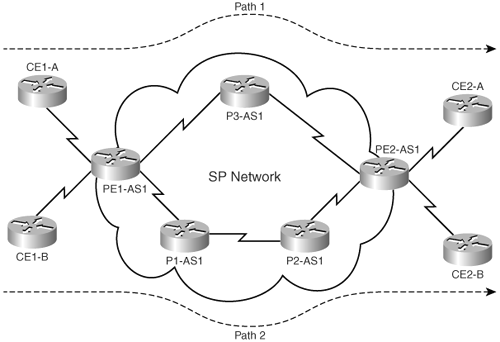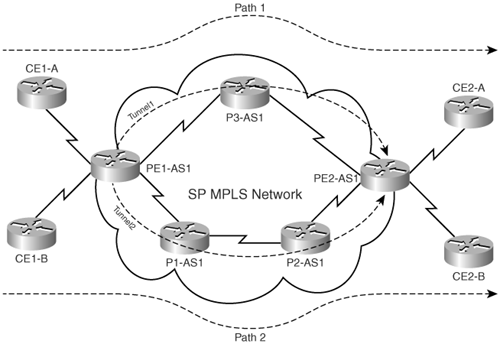TE Basics
TE is the process of steering traffic across to the backbone to facilitate efficient use of available bandwidth between a pair of routers. Prior to MPLS TE, traffic engineering was performed either by IP or by ATM, depending on the protocol in use between two edge routers in a network. Though the term "traffic engineering" has attained popularity and is used more in the context of MPLS TE today, traditional TE in IP networks was performed either by IP or by ATM.
TE with IP was mostly implemented by manipulation of interface cost when multiple paths existed between two endpoints in the network. In addition, static routes enabled traffic steering along a specific path to a destination. Figure 9-1 outlines a basic IP network with two customers, A and B, connected to the same service provider.
Figure 9-1. Traditional IP Networks

As illustrated in Figure 9-1, two paths exist between customer routers CE1-A and CE2-A via the provider network. If all links between the routers in Figure 9-1 were of equal cost, the preferred path between customer routers CE1-A and CE2-A would be the one with the minimum cost (via routers PE1-AS1, P3-AS1, and PE2-AS1) or PATH1. The same would apply for the customer routers CE1-B and CE2-B belonging to Customer B. If all the links were T3 links, for example, in the event of CE1-A sending 45 Mbps of traffic and CE1-B simultaneously sending 10 Mbps of traffic, some packets will be dropped at PE1-AS1 because the preferred path for both customers is using PATH1. The path PATH2 will not be utilized for traffic forwarding; therefore, TE can utilize this available bandwidth. To implement TE using IP whereby the paths PATH1 and PATH2 are either load balanced or used equally, we will need to implement IGP features such as maximum paths with variance or change the cost associated with the suboptimal path, PATH2, to make it equal to the current optimal path, PATH1. In an SP environment, this is often cumbersome to implement as the number of routers is much larger.
With ATM networks, the solution is a lot more feasible; PVCs can be configured between routers PE1-AS1 and PE2-AS1 with the same cost, but this would create a full mesh of PVCs between a group of routers. Implementing ATM for TE, however, has an inherent problem when a link or a node goes down. During link or node failure used in conjunction with ATM for TE, messages are flooded on the network. The Layer 3 topology must be predominantly fully meshed to take advantage of the Layer 2 TE implementation. Often, this might prove to be a scalability constraint for the IGP in use, due to issues with reconvergence at Layer 3.
The main advantage of implementing MPLS TE is that it provides a combination of ATM's TE capabilities along with the class of service (CoS) differentiation of IP. In MPLS TE, the headend router in the network controls the path taken by traffic to any particular destination in the network. The requirement to implement a full mesh of VCs, as in ATM, does not exist when implementing MPLS TE. Therefore, when MPLS TE is implemented, the IP network depicted in Figure 9-1 transforms into the label switched domain, as shown in Figure 9-2, in which the TE label switched paths or TE tunnels (Tunnel1 and Tunnel2) define paths that can be used by traffic between PE1-AS1 and PE2-AS1.
Figure 9-2. MPLS TE

MPLS Overview
- MPLS Overview
- Unicast IP Forwarding in Traditional IP Networks
- Overview of MPLS Forwarding
- MPLS Terminology
- MPLS Control and Data Plane Components
- MPLS Operation
- Special Outgoing Label Types
- Penultimate Hop Popping
- Frame-Mode MPLS
- Cell-Mode MPLS
Basic MPLS Configuration
- Basic MPLS Configuration
- Frame-Mode MPLS Configuration and Verification
- Cell-Mode MPLS over ATM Overview, Configuration, and Verification
- Command Reference
Basic MPLS VPN Overview and Configuration
- Basic MPLS VPN Overview and Configuration
- VPN Categories
- MPLS VPN Architecture and Terminology
- MPLS VPN Routing Model
- MPLS VPN Basic Configuration
- Outbound Route Filters
- Command Reference
PE-CE Routing Protocol-Static and RIP
- PE-CE Routing Protocol-Static and RIP
- Static PE-CE Routing Overview, Configuration, and Verification
- Static PE-CE Routing Command Reference
- RIPv2 PE-CE Routing Overview, Configuration, and Verification
- RIPv1 PE-CE Routing Configuration and Verification
- RIP PE-CE Routing Command Reference
PE-CE Routing Protocol-OSPF and EIGRP
- PE-CE Routing Protocol-OSPF and EIGRP
- OSPF PE-CE Routing Protocol Overview, Configuration and Verification
- EIGRP PE-CE Routing Protocol Overview, Configuration, and Verification
Implementing BGP in MPLS VPNs
- Implementing BGP in MPLS VPNs
- BGP PE-CE Routing Protocol Overview, Configuration, and Verification
- Implementing Route-Reflectors in MPLS VPN Networks
- Case Study-Hub and Spoke MPLS VPN Network Using BGP PE-CE Routing for Sites Using Unique AS Numbers
- Case Study-Hub and Spoke MPLS VPN Network with Sites Using Same AS Numbers
- Command Reference
Inter-Provider VPNs
- Inter-Provider VPNs
- Overview of Inter-Provider VPNs
- Option 1: Inter-Provider VPN Using Back-to-Back VRF Method
- Option 2: Inter-Provider VPNs Using ASBR-to-ASBR Approach
- Option 3: Multi-Hop MP-eBGP Between RR and eBGP Between ASBRs
- Option 4: Non-VPN Transit Provider
- Case Study-Inter-AS Implementing Route-Reflector and BGP Confederation in Provider Networks
- Case Study-Multi-Homed Inter-AS Provider Network
- Command Reference
Carrier Supporting Carriers
- Carrier Supporting Carriers
- Carrier Supporting Carriers Overview
- Deployment Scenarios with CSC Architecture
- CSC Architecture Benefits
- Command Reference
MPLS Traffic Engineering
- MPLS Traffic Engineering
- TE Basics
- MPLS TE Theory
- Constraint-Based Routing and Operation in MPLS TE
- Configuring MPLS TE
- Command Reference
Implementing VPNs with Layer 2 Tunneling Protocol Version 3
- Implementing VPNs with Layer 2 Tunneling Protocol Version 3
- L2TPv3 Overview
- Configuring L2TPv3 Tunnels for Layer 2 VPN
- Configuring L2TPv3 Static Tunnels
- Configuring L2TPv3 Dynamic Tunnels
- Implementing Layer 3 VPNs over L2TPv3 Tunnels
- Command Reference
Any Transport over MPLS (AToM)
- Any Transport over MPLS (AToM)
- Introduction to Layer 2 VPNs
- Implementing AToM for Like to Like Circuits
- L2 VPN-Any to Any Interworking
- Local Switching
- Command Reference
Virtual Private LAN Service (VPLS)
- Virtual Private LAN Service (VPLS)
- VPLS Overview
- VPLS Topology-Single PE or Direct Attachment
- Hierarchical VPLS-Distributed PE Architecture
- Command Reference
Implementing Quality of Service in MPLS Networks
- Implementing Quality of Service in MPLS Networks
- Introduction to QoS-Classification and Marking
- MPLS QoS Implementation
- MPLS QoS Operating Modes
- Modular QoS CLI: Configuration of QoS on Cisco Routers
- Configuration and Implementation of MPLS QoS in Uniform Mode and Short Pipe Mode Operation
- Implementing MPLS QoS for Layer 2 VPN Implementations
- Command Reference
MPLS Features and Case Studies
- MPLS Features and Case Studies
- Case Study 1: Implementing Multicast Support for MPLS VPNs
- Case Study 2: Implementing Multi-VRF CE, VRF Selection Using Source IP Address, VRF Selection Using Policy-Based Routing, NAT and HSRP Support in MPLS VPN, and Multicast VPN Support over Multi-VRF CE
- Case Study 3: Implementing Layer 2 VPNs over Inter-AS Topologies Using Layer 2 VPN Pseudo-Wire Switching
- Case Study 4: Implementing Layer 3 VPNs over Layer 2 VPN Topologies and Providing L2 VPN Redundancy
- Case Study 5: Implementing Dynamic Layer 3 VPNs Using mGRE Tunnels
- Case Study 6: Implementing Class-Based Tunnel Selection with MPLS Traffic Engineering
- Case Study 7: Implementing Hub and Spoke Topologies with OSPF
- Case Study 8: Implementing Hub and Spoke Topologies with EIGRP
- Case Study 9: Implementing VPLS Services with the GSR 12000 Series
- Case Study 10: BGP Site of Origin
- Command Reference
EAN: 2147483647
Pages: 130
